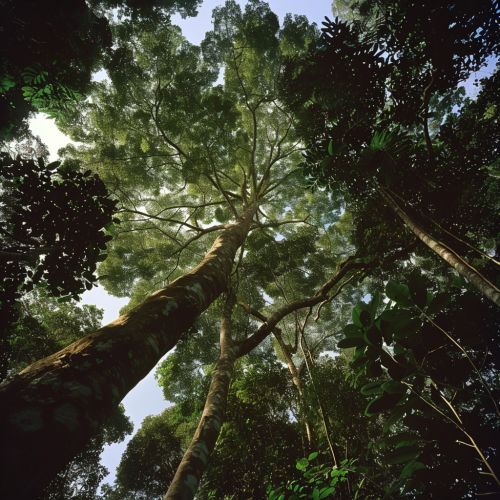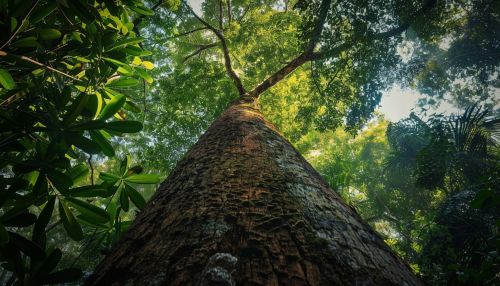Emergent trees: Difference between revisions
(Created page with "== Introduction == Emergent trees are a critical component of tropical rainforests, towering above the forest canopy and playing a vital role in the ecosystem. These trees are characterized by their significant height, often reaching up to 60 meters or more, and their ability to access sunlight that is unavailable to shorter vegetation. This article delves into the biology, ecological significance, and conservation of emergent trees, providing a comprehensive understand...") |
No edit summary |
||
| Line 7: | Line 7: | ||
Emergent trees exhibit several unique characteristics that distinguish them from other forest trees. They possess extensive root systems that provide stability and support, allowing them to withstand strong winds and heavy rains. Their trunks are often buttressed, with wide bases that taper as they ascend. The leaves of emergent trees are typically large and adapted to capture maximum sunlight. | Emergent trees exhibit several unique characteristics that distinguish them from other forest trees. They possess extensive root systems that provide stability and support, allowing them to withstand strong winds and heavy rains. Their trunks are often buttressed, with wide bases that taper as they ascend. The leaves of emergent trees are typically large and adapted to capture maximum sunlight. | ||
[[Image:Detail-91621.jpg|thumb|center|An emergent tree towering above the forest canopy in a tropical rainforest.|class=only_on_mobile]] | |||
[[Image:Detail-91622.jpg|thumb|center|An emergent tree towering above the forest canopy in a tropical rainforest.|class=only_on_desktop]] | |||
=== Height and Structure === | === Height and Structure === | ||
Latest revision as of 10:21, 20 June 2024
Introduction
Emergent trees are a critical component of tropical rainforests, towering above the forest canopy and playing a vital role in the ecosystem. These trees are characterized by their significant height, often reaching up to 60 meters or more, and their ability to access sunlight that is unavailable to shorter vegetation. This article delves into the biology, ecological significance, and conservation of emergent trees, providing a comprehensive understanding of their role in tropical ecosystems.
Characteristics of Emergent Trees
Emergent trees exhibit several unique characteristics that distinguish them from other forest trees. They possess extensive root systems that provide stability and support, allowing them to withstand strong winds and heavy rains. Their trunks are often buttressed, with wide bases that taper as they ascend. The leaves of emergent trees are typically large and adapted to capture maximum sunlight.


Height and Structure
Emergent trees can grow to impressive heights, often exceeding 60 meters. This height advantage allows them to access sunlight that is otherwise blocked by the dense canopy layer. The structure of these trees is adapted to support their massive size, with thick, sturdy trunks and extensive root systems. The buttressed roots provide additional stability, anchoring the tree firmly in the soil.
Leaf Adaptations
The leaves of emergent trees are typically large and broad, maximizing their surface area for photosynthesis. These leaves are often waxy or hairy, adaptations that help reduce water loss and protect against herbivory. The positioning of the leaves also plays a crucial role in light capture, with many emergent trees displaying a spiral leaf arrangement to minimize shading of lower leaves.
Ecological Significance
Emergent trees play a pivotal role in the ecology of tropical rainforests. They contribute to the forest structure, provide habitat for numerous species, and influence local climate and hydrology.
Habitat Provision
The towering height of emergent trees creates unique microhabitats that are not found in the lower forest layers. These trees provide nesting sites for birds, roosting spots for bats, and habitat for various epiphytes and invertebrates. The complex structure of emergent trees supports a high diversity of species, contributing to the overall biodiversity of the rainforest.
Climate Regulation
Emergent trees play a significant role in regulating local climate conditions. Their large canopies intercept rainfall, reducing soil erosion and promoting water infiltration. The transpiration process in these trees contributes to local humidity levels, influencing weather patterns and maintaining the rainforest's microclimate.
Carbon Sequestration
Due to their large biomass, emergent trees are important carbon sinks. They sequester significant amounts of carbon dioxide through photosynthesis, helping to mitigate the effects of climate change. The carbon stored in the wood and leaves of these trees represents a substantial portion of the forest's total carbon stock.
Species of Emergent Trees
Several species of trees are classified as emergent, each with unique adaptations and ecological roles. Some notable examples include:
Dipterocarps
Dipterocarps are a family of tropical hardwood trees found primarily in Southeast Asia. They are among the tallest trees in the world, with some species reaching heights of over 80 meters. Dipterocarps are known for their large, winged seeds, which are dispersed by wind.
Ceiba pentandra
Commonly known as the kapok tree, Ceiba pentandra is native to tropical America and West Africa. It is characterized by its massive trunk and buttressed roots. The kapok tree produces large, showy flowers and fluffy seed pods that are dispersed by wind.
Shorea robusta
Shorea robusta, also known as sal tree, is native to the Indian subcontinent. It is a dominant species in the tropical moist deciduous forests of the region. The sal tree is valued for its hardwood timber and resin.
Conservation of Emergent Trees
The conservation of emergent trees is crucial for maintaining the health and biodiversity of tropical rainforests. These trees face several threats, including deforestation, climate change, and illegal logging.
Threats
Deforestation is the primary threat to emergent trees, driven by agricultural expansion, logging, and infrastructure development. Climate change poses additional risks, as altered temperature and precipitation patterns can affect tree growth and survival. Illegal logging, often targeting high-value timber species, further exacerbates the decline of emergent trees.
Conservation Strategies
Effective conservation strategies for emergent trees include the establishment of protected areas, sustainable forest management practices, and reforestation efforts. Protected areas provide a refuge for these trees and the species that depend on them. Sustainable forest management practices, such as selective logging and reduced-impact logging, help minimize the ecological footprint of timber extraction. Reforestation and afforestation projects aim to restore degraded landscapes and increase forest cover.
